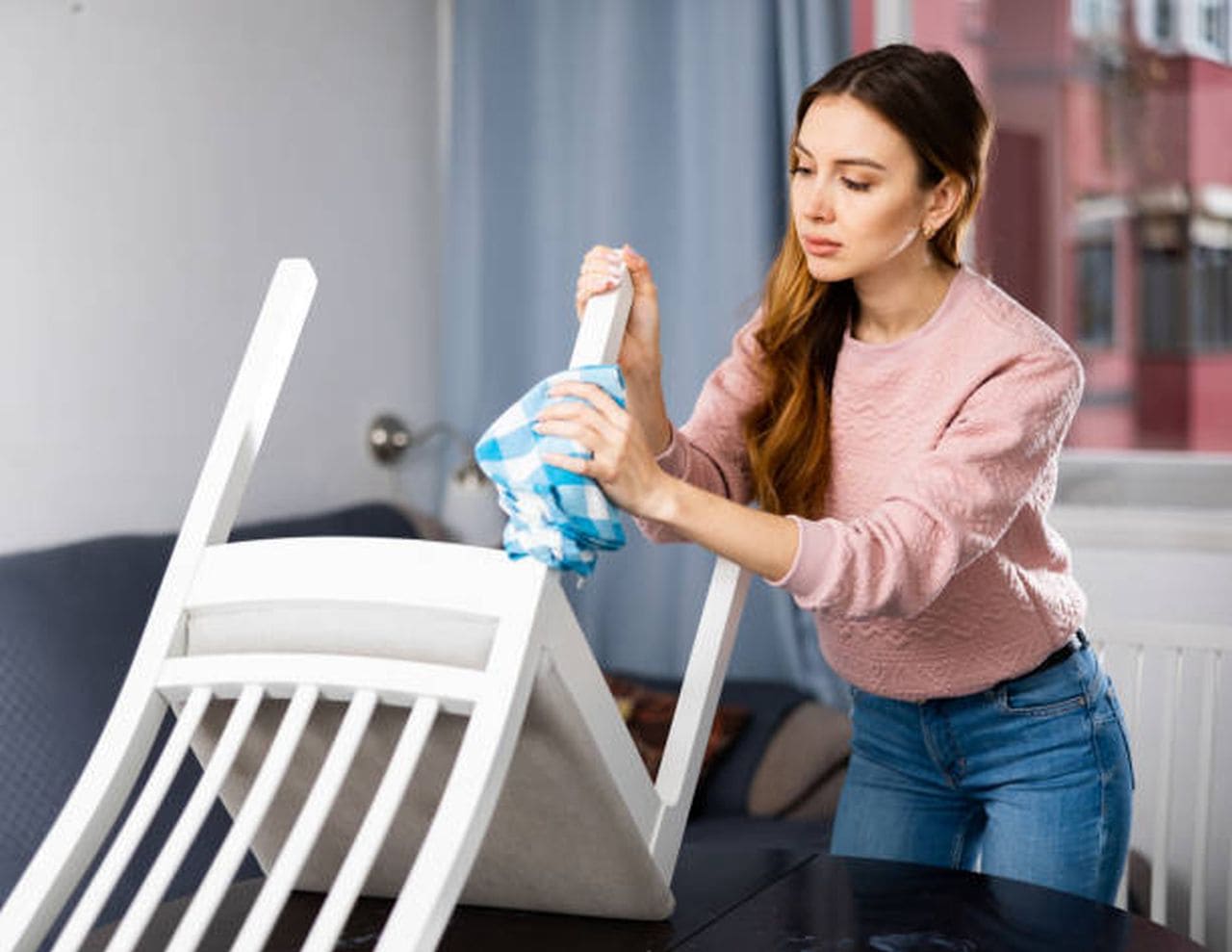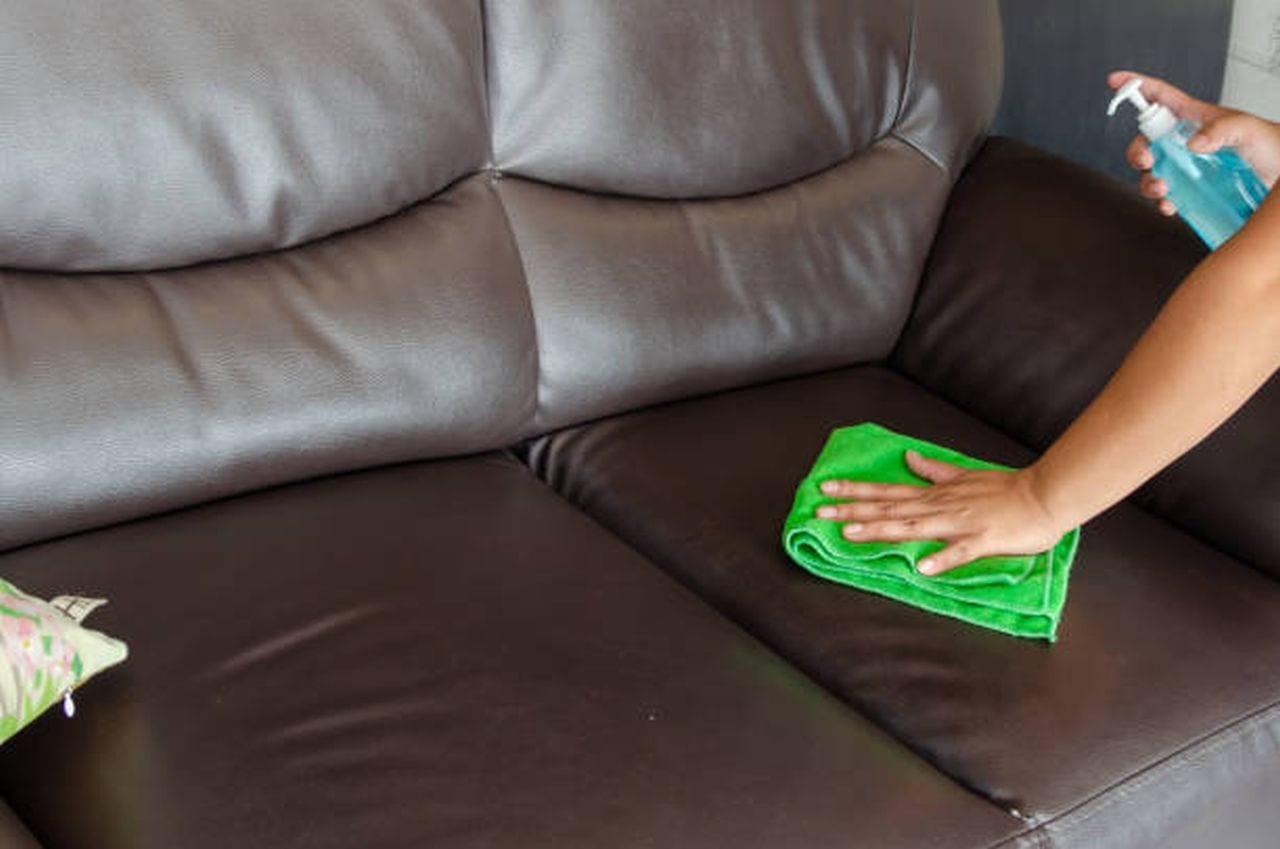Maintaining cleanliness on furniture not only makes it seem better but also greatly increases its longevity. Cleaning all the furniture in a house can seem daunting, but it doesn't have to be. Most furniture may be kept in pristine condition with frequent dusting, vacuuming, and semiannual deep cleanings.
The same cleaning solution or method may need to be revised on various pieces of furniture. Examine different cleaning and maintenance strategies to see what works best for indoor and outdoor furniture.
It would be lovely if a magic elixir could restore the original condition of every piece of furniture in your home, no matter the material or build. No "one-size-fits-all" method of cleaning furniture has been developed by modern science.
Products that work well on microfiber fabrics are ineffective on leather, and vice versa. What is appropriate and desired for usage on ancient wooden furniture may degrade or damage sleek and modern metal.
This cleaning guide was compiled to assist homeowners in determining the appropriate cleaning method for each common furniture type. Our "secret weapon" for cleaning each material type is a list of our recommended cleaning products.
Instructions for Maintaining Your Furnishings
Upholstery Maintenance
Vacuum It.
The easiest aspect of keeping your furniture clean is to vacuum it regularly. Make an effort to clean the spaces between cushions on your furniture, such as the seam where a sofa's arms meet the back. You should also remove the cushions and thoroughly vacuum all of their sides.
Microfiber's high fibre density prevents stains and allows most dirt and debris to be brushed off. Brush it out first, then hit it with the vacuum.
Make Your Own Water-Based Cleaner With Dish Soap.
Put some liquid dish soap (not powder) into a spray bottle full of water. Combined in a cup, white vinegar and baking soda will neutralise any unpleasant odours. Could you give it a good shake?
Try The Laundry Detergent In A Hidden Area First.
Put the detergent mixture on a sponge and rub it over the underside or back of the furniture, where it won't be seen. After dabbing the excess moisture with a towel, let the area air dry. If the detergent mixture turns colours, do not use it. Instead, it would help to hire a professional furniture cleaning service.
Use A Sponge To Dampen The Stains.
Apply the solution with a sponge and work it into the wood or fabric, then wipe it out with a dry cloth. Any stains or stubborn spots should be given several minutes for the detergent to soak in.
Leather Furniture Maintenance
Make Sure To Vacuum Your Furniture.
To avoid scratching or denting the furniture, vacuum with the soft brush attachment. Similar to upholstery, wood furniture may be kept clean with regular vacuuming. Remove the cushions to guarantee you can get to every crevice in the furniture.
To Remove Grime And Spot Cleaning, Use Mild Dish Soap And Water.
A small bucket of warm water should add around 1–2 tablespoons (15–30 mL) of mild dish detergent. Then, rinse the surface with clean water before wiping it off with a moist cloth dipped in soapy water. Then, move on to cleaning the furniture's soiled surfaces. Then, use a dry cloth to pat the furniture dry.
Always begin with the least aggressive cleaner and work up to the more powerful option if necessary. If regular detergent is ineffective, try using vinegar instead.
Try A Vinegar Solution Instead If Soap And Water Don't Clean Your Furniture.
Combine an equal amount of vinegar and water in a bucket. Wipe clean your furniture by soaking a rag in the liquid, wringing it out so that it is damp but not dripping wet, and then using it. To prevent spreading grime, rinse the rag frequently and use a dry cloth to finish the job.
Shared equally, Spot cleaning with a mixture of lemon juice and cream of tartar works wonders on white and beige couches. Apply the mixture to the stain and leave it alone. If any residue remains after 10 minutes, wipe it away.
Ink stains and mildew are no match for rubbing alcohol sprayed with a cotton swab. Dry the area with a blow dryer after working it in fast.
Use Vinegar And Linseed Oil To Nourish The Leather.
Vinegar plus linseed oil at a ratio of 1:1 should be used. Please put it in the shaker, rub it well, and wait 10 minutes. Finally, polish it with a soft cloth. There may be a need for more than one boost.
After cleaning your leather furniture, you can re-moisturise it by applying a leather cream.
Maintenance of Wooden Furniture
Find Out Which Finish Was Used On Your Furniture.
To be safe, start with a light cleanser and work your way up to more aggressive cleaning solutions based on the furniture's reaction (or lack thereof). Whether your furniture is stained, painted, or something else entirely, you should treat it with care tailored to its specific finish.
When cleaning wooden surfaces, it's best to avoid soaking the piece too long and use only a small amount of water. Wood that has been exposed to water may warp and break.

Cleaning The Wood Of Dust And Loose Dirt.
To remove the dust and grime from the furniture's surface, run a clean cloth over it. Feather dusters should be avoided on wooden furniture because their quills might leave scratches. Make do with some fabric.
Wash Any Stains Or Dirt Off With A Gentle Soap And Water.
Add 1–2 tablespoons (15–30 mL) mild dish detergent to a small pail of warm water. After washing in soapy water, wring out the fabric. Dust wooden surfaces with the cloth. Then, use a clean cloth to dry the furniture.
Before resorting to harsher cleaners, use only water and mild soap first. Mineral spirits can further clean the wood if other methods have failed.
If Soap Doesn't Clean The Wood, Try Mineral Spirits.
Mineral spirits like paint thinner are great for scrubbing away grime buildup. Put some of the booze on a rag and use it to polish your furniture. Use mineral spirits only in a well-ventilated area. Use a moist towel to wipe off any lingering cleaner.
Although it is safe for most wooden furniture, it is a good idea to test the cleaner on a small, hidden area of your furniture (such as the underside of a chair leg) to be sure there will be no adverse reactions.
Cleaning Furniture Made of Acrylic or Lucite
If You Need To Wipe It Down, Use A Fresh Cloth.
Minimal care is required for acrylic and lucite. However, a cloth used to clean other surfaces can harm the material. To avoid scratching your furniture, always use a clean, fresh cloth.
Don't Use Windex Or Other Window Cleaners.
Avoid the temptation to clean your acrylic furniture using glass cleaner just because it's transparent. Acrylic and lucite are fragile, so only use cleaners specifically made for them.
Don't use a solvent to remove something that's adhered to your furniture. Only use a damp cloth or cleaning products made for that purpose.
Use Plastic Polish To Get Rid Of Scratches.
The polish can also be used to fix scratches in wood furniture. Scratched plastic can be easily repaired using a drop of plastic cleaner and buffing it with a soft cloth.
Only cleaners made specifically for plastic should be used on acrylic furniture.
Maintaining Your Wicker Furniture
Find Out What It Is Made Of.
"wicker" describes the method rather than the material used to build the furniture. The type of care required for your wicker furniture may vary slightly depending on the material it is made from.
Take Out The Pillows.
As specified by the manufacturer, separate cleaning procedures shall be used for these. Get comfortable with reaching across the piece of furniture.
Put The Vacuum's Brush Attachment To Good Use.
Wicker furniture requires sensitive cleaning methods and equipment. Maintaining your furniture's cleanliness is as simple as brushing it periodically and vacuuming it with the brush attachment.
Use a delicate paintbrush to get rid of stubborn dust. Use a toothbrush to get rid of dust in hard-to-reach places.
Use A Soft-Bristled Brush And Water Mixed With Ammonia To Clean Rattan And Bamboo.
In a bucket, combine one part of ammonia with two parts of water, and then add some bleach-free dish soap. A brush is best for cleaning, but a clean towel will do in a pinch.
Mix chemicals only in a well-ventilated environment, and always wear protective gear while working with ammonia. Please avoid leaning over the barrel.
There should not be any bleach residue. When combined, ammonia and bleach form very poisonous vapours. Step outside if you start to feel dizzy or queasy when preparing your cleaning solutions.
Even while washing, wicker furniture requires special care. A professional should be called in if you plan on using a stiff brush or anything more abrasive on your furniture, as this can cause serious damage.
You can skip the detergents and wipe out your paper and grass-wicker furniture with a moist towel.
This thorough cleaning of wicker furniture is only required twice yearly.

Hang It Up In The Open Air To Dry.
Even if it takes a few days, drying your wicker furniture completely is essential. Wet cane, bamboo, and grass will progressively resume their pre-woven forms.
It is important never to leave wicker furniture soaking wet and completely dry it after every washing. Wicker furniture should never be used if it is wet.
However, wicker furniture should be kept from direct sunlight for a short time. Sun-exposed chairs and tables should be rotated year-round to prevent splitting.
Additional Advice on Cleaning Your Couch
A lint roller is the quickest and most convenient way to remove minor particles from a fabric couch, such as crumbs or stray hairs. An excellent handheld vacuum can rapidly clean up greater volumes of pet hair or crumbs without the inconvenience of carrying out a full-size vacuum.
Sofas made of unfinished leather that has been stained will probably need to be taken to an expert.
The Signs That It's Time To Get Help
Only polish or deep clean wood furniture if you believe it may be an antique or collectable made by a renowned wood manufacturer after first having it examined by a professional appraiser.
Keep in mind that solid wood furniture of high quality lasts for generations. Repairing furniture with minor damage, such as loose joints or surface scratches, is much more cost-effective than buying a new one. Reusing or upcycling is far preferable to throwing something away because of environmental concerns.
A skilled repairer can make your wooden furniture look as good as new. Gouges, dents, ugly scratches, and fissures in the wood can be sanded and filled. They may paint, stain, and seal it to change the colour if you get weary of it or have it matched to another wood tone in your home.
Furniture repair or restoration can save you much money than buying brand-new pieces.
Frequently Asked Questions About Cleaning Services
Delicate or antique furniture should be cleaned with extreme care. Consult a professional or use a dry, soft cloth for gentle dusting.
Dusting or light cleaning should be done weekly, while more thorough cleaning can be done every 1-3 months, depending on use and the type of furniture.
No, not all furniture requires polish. It's suitable for some wood furniture but should be avoided on surfaces like leather and fabric.
For stains, refer to the manufacturer's instructions, or consult a professional for guidance on appropriate stain removal.
Yes, outdoor furniture requires different cleaning methods based on the material, such as using a hose and mild soap for plastic or metal furniture or specialty cleaners for wood or wicker. Follow the manufacturer's recommendations.
Conclusion
Keeping furniture clean not only makes it look better, but it also makes it last longer. Regular sweeping, dusting, and deep cleaning every six months can help keep the furniture in good shape. The truth is, though, that there is no one way to clean all types of furniture. For example, microfiber materials might need a certain kind of cleaner, while leather might need a different method.
Vacuuming is very important for upholstery, especially between the pillows. Odours can be taken away with a water-based cleaner that has dish soap and vinegar in it. It's okay to use laundry detergent in a secret spot, but if it turns colours, you should get help. Another good way is to use a sponge to soak up the colour.
To keep leather furniture from getting scratched or dented, you must clean it regularly. You can clean up grime and spots with water and mild dish soap. If soap and water don't work, you can use a vinegar mix instead. Lemon juice and cream of tartar can be used to clean spots on white and beige chairs.
Vinegar and olive oil can be used to keep leather furniture in good shape. After cleaning the leather, use a leather cream to keep it wet. Start with a mild cleaner for wooden furniture and work your way up to stronger cleaners based on how the furniture reacts. Do not soak the piece for too long, and use little water to keep it from breaking or twisting.
To clean wood furniture, wipe it down with a clean cloth to get rid of dirt and dust. Use water and gentle dish soap to get rid of any stains or dirt. Then, use mineral spirits, which are similar to paint thinner, to scrub away the buildup of grime. Try the cleaner on a small, hidden area first to make sure it doesn't hurt anything.
Do not use Windex or other window cleaners on plastic or lucite furniture. Instead, wipe it down with a clean cloth. To get rid of scratches, use plastic polish and cleaners made just for plastic.
To take care of your wicker furniture, follow the manufacturer's guidelines and take out the pillows. To clean rattan and bamboo, use a soft-bristled brush and water mixed with ammonia. After every wash, make sure the furniture is fully dry. Don't leave it wet.
Paper and grass-wicker chairs should be cleaned thoroughly every two years. Don't leave the furniture wet; hang it outside to dry. To keep wicker furniture from breaking, move it around the house all year and keep it out of direct sunlight for short periods of time.
For small particles, use a lint roller or a handheld vacuum when cleaning cloth couches. Also, take care of leather sofas that aren't finished yet.
It's time to get help. Only polish or deep clean wood furniture that is old or collectable and made by a well-known wood maker. There is a cheaper way to get good furniture than to buy a new one. Skilled repairers can make wooden furniture look like it's brand new.
Content Summary
- Proper furniture cleaning enhances its longevity.
- Regular maintenance keeps the furniture looking pristine.
- No universal cleaning solution for every furniture type exists.
- Avoid products on materials they aren’t intended for.
- Discover the right cleaning method for various furniture materials.
- Dusting, vacuuming, and deep cleaning: the furniture maintenance trifecta.
- Your upholstery's best friend? Regular vacuuming.
- Dive deep into sofa crevices for a thorough clean.
- Brush off dirt from the microfiber before vacuuming.
- DIY water-based cleaner: dish soap, white vinegar, and baking soda.
- Test detergent on hidden furniture areas before full application.
- Use a sponge to apply cleaning solution on stains.
- Leather furniture also benefits from gentle vacuuming.
- Mild dish soap and water: a gentle combo for leather cleaning.
- For tougher grime on leather, consider vinegar solutions.
- Lemon juice and cream of tartar work wonders on light leather stains.
- Tackle ink stains on leather with rubbing alcohol.
- Nourish leather with a mix of vinegar and linseed oil.
- Re-moisturise leather furniture post-cleaning with leather cream.
- Identify the finish on wooden furniture before cleaning.
- Limit water exposure when cleaning wooden pieces.
- Opt for gentle soap and water for wooden furniture cleaning.
- Tougher stains on wood? Try mineral spirits in well-ventilated areas.
- Test any cleaning product on a hidden wooden area first.
- For acrylic or Lucite furniture, always use a fresh cloth.
- Avoid generic window cleaners on acrylic furniture.
- Buff out acrylic scratches with plastic polish.
- Wicker's care varies based on its construction material.
- Use a vacuum brush attachment for gentle wicker cleaning.
- Rattan and bamboo wicker? Clean with ammonia, water, and soap mix.
- Ensure wicker furniture dries completely after cleaning.
- Shield wicker furniture from prolonged direct sunlight.
- Lint rollers are quick fixes for crumbs on fabric couches.
- Unfinished leather stains? Consider professional help.
- Antique wood furniture? Get a professional appraisal before polishing.
- Quality wooden furniture can last for generations.
- Repair minor damages instead of buying new furniture.
- Upcycling is environmentally friendlier than discarding.
- Professionals can restore damaged wooden furniture seamlessly.
- Furniture restoration is a cost-effective alternative to new purchases.
- Periodic cleaning keeps indoor and outdoor furniture in top shape.
- Selective cleaning methods prevent furniture degradation.
- DIY solutions can effectively tackle everyday furniture stains.
- Repeated cleaning procedures keep furniture looking brand new.
- Proper maintenance procedures prolong furniture's life.
- Furniture repair gives pieces a second lease on life.
- Know the material of your furniture for the best care practices.
- Individual cleaning guides ensure material safety.
- Professional furniture cleaning services are an option for stubborn stains.
- With the right care, your furniture can be a long-lasting investment.
